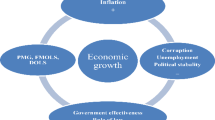Abstract
This paper sheds light on global GDP spillovers in the context of external imbalances. We adopt a Bayesian time-varying panel vector autoregression framework to analyze the global implications of changes in assets and liabilities of the US and the Euro Area in a global framework which includes 25 industrial and emerging economies. We find significant evidence for assets and liabilities spillovers from positions in the Euro Area and the US which often result in negative effects on GDP growth.




Similar content being viewed by others
Notes
For some economies these have been replaced by money market rates due to data availability.
This also confirms the findings provided by Wegener et al. (2019).
References
Ananchotikul N, Zhang L (2014) Portfolio flows, global risk aversion and asset prices in emerging markets. IMF Working Paper No. 14/156
Beckmann J, Czudaj R (2017a) Capital flows and gdp in emerging economies and the role of global spillovers. J Econ Behav Organ 142:140–163
Beckmann J, Czudaj R (2017b) Effective exchange rates, current accounts and global imbalances. Rev Int Econ 25:500–533
Beckmann J, Belke A, Czudaj R (2014) Does global liquidity drive commodity prices? J Bank Financ 48:224–234
Bekaert G, Harvey CR, Lundblad C (2005) Does financial liberalization spur growth? J Financ Econ 77:3–55
Bénassy-Quéré A, Mignon V, Penot A (2007) China and the relationship between the oil price and the dollar. Energy Policy 35:5795–5805
Blanchard O, Ostry JD, Ghosh AR, Chamon M (2015) Are capital inflows expansionary or contractionary? Theory, policy implications, and some evidence. NBER Working Papers No. 21619
Bluedorn JC, Duttagupta R, Guajardo J, Topalova P (2013) Capital flows are fickle: Anytime, anywhere. IMF Working Papers No. WP/13/183
Broner F, Didier T, Erce A, Schmukler SL (2011) Gross capital flows – Dynamics and crises. World Bank – Policy Research Working Paper No. 5768
Buiter W (2006) Dark matter or cold fusion? Global Economics Paper No. 136
Canova F, Ciccarelli M (2009) Estimating multicountry VAR models. Int Econ Rev 50:929–959
Canova F, Ciccarelli M (2013) Panel vector autoregressive models: a survey. In: VAR Models in Macroeconomics – New Developments and Applications: Essays in Honor of Christopher a. sims, chap 6, pp 205–246
Caporale GM, Menla Ali F, Spagnolo N (2015) Exchange rate uncertainty and international portfolio flows: A multivariate GARCH-in-mean approach. J Int Money Financ 54:70–92
Chinn MD, Wei SJ (2013) A faith-based initiative meets the evidence: Does a flexible exchange rate regime really facilitate current account adjustment? Rev Econ Stat 95:168–184
Chinn MD, Eichengreen B, Ito H (2014) A forensic analysis of global imbalances. Oxf Econ Pap 66:465–490
Cline WR (2005) The United States as a debtor nation washington. DC: Columbia University Press
Comunale M (2017) Dutch disease, real effective exchange rate misalignments and their effect on GDP growth in EU. J Int Money Financ 73:350–370
Della Corte P, Sarno L, Sestieri G (2012) The predictive information content of external imbalances for exchange rate returns: How much is it worth? Rev Econ Stat 94:100–115
Devereux MB, Sutherland A (2010) Valuation effects and the dynamics of net external assets. J Int Econ 80:129–143
Eng YK, Wong CY (2016) Asymmetric growth effect of capital flows: Evidence and quantitative theory. Econ Syst 40:64–81
Forbes KJ, Warnock FE (2012) Capital flow waves: surges, stops, flight, and retrenchment. J Int Econ 88:235–251
Fratzscher M (2012) Capital flows, push versus pull factors and the global financial crisis. J Int Econ 88:341–356
Hannan SA (2017) The drivers of capital flows in emerging markets post global financial crisis. IMF Working Papers 17/52
Hausmann R, Sturzenegger F (2007) The missing dark matter in the wealth of nations and its implications for global imbalances. Econ Policy 22:469–518
Hoffmann M, Krause MU, Tillmann P (2019) International capital flows, external assets and output volatility. J Int Econ 117:242–255
IMF (2008) Classification of Financial Assets and Liabilities. International Monetary Fund
Kim Y (2000) Causes of capital flows in developing countries. J Int Money Financ 19:235–253
Lane PR, Milesi-Ferretti GM (2012) External adjustment and the global crisis. J Int Econ 88:252–265
Lane PR, Milesi-Ferretti GM (2014) Global imbalances and external adjustment after the crisis. IMF Working Papers 14/151
Lane PR, Milesi-Ferretti GM (2017) International financial integration in the aftermath of the global financial crisis. IMF Working Papers 17/115
Milesi-Ferretti GM, Blanchard OJ (2009) Global imbalances; in midstream? IMF Staff Position Notes 2009/29
Obstfeld M, Rogoff KS (2005) Global current account imbalances and exchange rate adjustments. Brook Pap Econ Act 36:67–146
Obstfeld M, Rogoff KS (2009) Global imbalances and the financial crisis: Products of common causes. In: Federal Reserve Bank of San Francisco Proceedings, pp 131–172
Pesaran MH, Schuermann T, Weiner SM (2004) Modeling regional interdependencies using a global error-correcting macroeconometric model. J Bus Econ Stat 22:129–162
Schmitt-Grohe S, Uribe M, Woodford M (2016) International Macroeconomics. Columbia University, Mimeo
Wegener C, Kruse R, Basse T (2019) The walking debt crisis. J Econ Behav Organ 157:382–402
Author information
Authors and Affiliations
Corresponding author
Additional information
Publisher’s Note
Springer Nature remains neutral with regard to jurisdictional claims in published maps and institutional affiliations.
Thanks for valuable comments are due to two anonymous reviewers and the participants of the conference on “Finance and Economic Growth in the Aftermath of the Crisis” in Milan/Italy and the 17th annual conference of the European Economics and Finance Society in London/UK.
Rights and permissions
About this article
Cite this article
Beckmann, J., Czudaj, R.L. Net Foreign Asset Positions, Capital Flows and GDP Spillovers. Open Econ Rev 31, 295–308 (2020). https://doi.org/10.1007/s11079-019-09563-5
Published:
Issue Date:
DOI: https://doi.org/10.1007/s11079-019-09563-5




